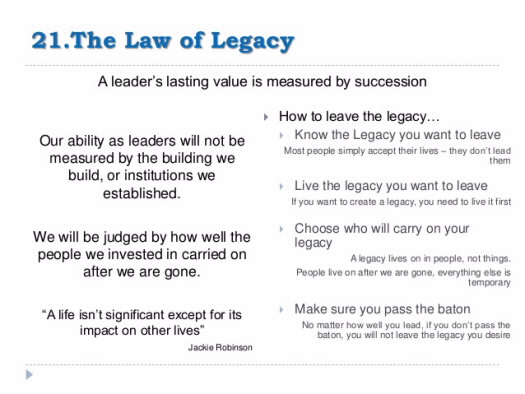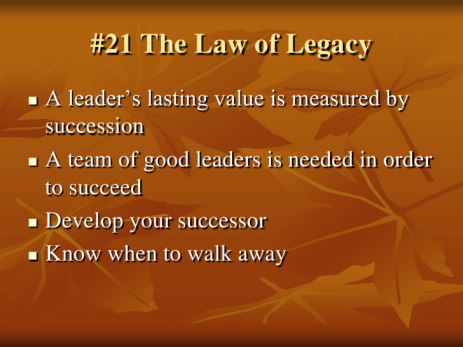Click here to return to Blog Post Intro
To create a legacy, be strategic and intentional. Consider taking these steps:
1. Decide ahead of time what you are willing to give up.
Being a leader has a price. Remember the Law of Sacrifice? Being a leader who leaves a legacy has an even greater price. When you work to create a legacy, your life is no longer your own. That’s why it’s important to know what you are willing to give up so others can go up.
2. Take the initiative to start the process.
If you want to create a legacy, you have to initiate the process–and there will be times when you’ll have to fight for it. Jesus’ followers even had several agendas. Some, like Simon the Zealot, wanted Him to lead a revolt against Rome. Others, like James and John (Mark 10:37) wanted positions of power.
3. Know your goals with each person.
The process of creating a legacy relies primarily on people. It requires selecting the right people and the right development process for each individual. Jesus carefully chose His legacy carriers. Scripture tells us He intentionally picked the twelve He wanted. And He didn’t treat all of them the same way. He had a specific development process for each of them.
4. Prepare to pass the baton well.
Once you have prepared your successors, you need to prepare for the transition. There’s a real art to preparing a successor, and it doesn’t always go smoothly. Jesus had trouble handing the baton to His followers. He appeared to them after His resurrection and gave them the Great Commission because some of them still didn’t get it.
As you prepare to hand off to a successor, do everything you can for a smooth transition. And even then, plan to offer additional assistance without getting in the way.
Jesus’ IDEA for Leaving a Legacy
Jesus faced the task of changing the lives of people thousands of years after Him—and He succeeded. Consider Jesus’ IDEA for working in the lives of people:
Instruction
Jesus constantly taught, most often with parables. More than half of the Gospels’ content presents Jesus’ teaching. When the disciples asked Him the meaning of his parables, He explained them, revealing insightful truths cloaked in the stories.
Demonstration
If Jesus had taught the disciples and done nothing more, they never would have carried on His legacy. But Jesus shared life with them. Jesus’ disciples went through three phases in their training:
- Come and see. Jesus invited them to observe Him and His priorities.
- Come and follow Me. Jesus asked for a greater level of commitment than to simply observe—they were to associate with Him.
- Come and be with Me. This phase occupied most of Jesus’ three years of ministry. He required the disciples’ commitment and companionship. The Twelve were present with Him as He taught, traveled, prayed, ate with “sinners,” healed the sick, and raised the dead. They saw the consistency between His words and actions (integrity), and they learned the how and why of all He did.
Experience
After Jesus modeled good leadership and taught spiritual truths, He didn’t turn His men loose and move on. He gradually worked them into positions of independent leadership by giving them valuable experience. Jesus gave His followers an opportunity to practice what He had taught and to practice leadership.
Assessment
Jesus repeatedly evaluated the progress of His disciples. After the return of the seventy, He debriefed them, gave them instruction concerning priorities, and celebrated with them (Luke 10:17-24). Jesus also gave His disciples specific feedback concerning their character and capabilities.
If you want to leave a legacy, you must look to people to carry it for you. Find the right people, and use the right preparation process for each of them. Only as you pour yourself into them will they be able to pour out themselves for others. No one can give what she or he does not have…

